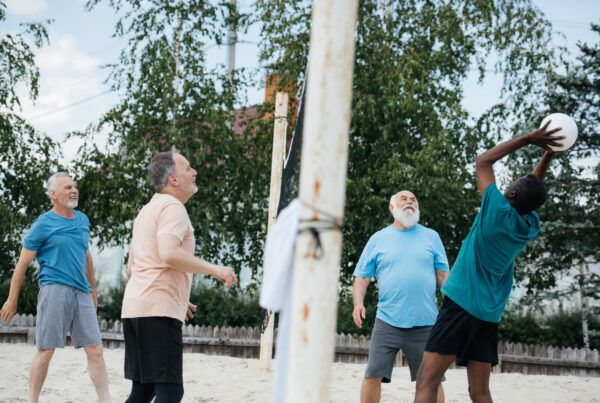”Question: Is there an exercise challenge that my entire family can do together this summer?
Reading time: 9 Minutes
MWi Hacks:
- Learn different ways to exercise with your loved ones
- Understand how to get started with an event that will inspire others
MWi Summary:
- To get started with a family fitness challenge, it is helpful to set inspiring and achievable goals and provide incentives.
- Challenges are more likely to be successful if you add a little activity at a time and if you plan for a variety of activities.
- Eating more healthily can also aid to the success of a family fitness challenge. Focus on planning meals ahead and learning about nutrition together.
- Other healthy lifestyle choices include drinking water, getting enough sleep, and taking breaks from technology.
- Even after the formal challenge ends, find other fitness goals for your family to look forward to like running a 5k.
Resolving to be healthier is a common goal for families, but it’s not always easy to get started. Use these tips to plan a successful family fitness challenge that will pay off for months and years to come.
Getting Started
- Plan a Kickoff Event – Whether you’re organizing for your community or your own family, build shared enthusiasm from the start. Providing opportunities for group members to give input will ensure all participants feel invested in the program.
- Set Inspiring and Achievable Goals – They need not be the same for everyone. Goals can be as simple as increasing the number of days of physical activity each week or eating out less often or as specific as reaching a daily number of steps.
- Track Progress – Plan how participants log a number of activities, minutes of exercise, steps taken, new nutrition goals, or whatever parameters your challenge focuses on. There are also many online trackers available that challenges can recommend, but depending on the ages involved and family dynamics, sometimes the old-school star chart still works wonders.
- Provide Incentives – Look for the right motivators for successes based on the ages and goals of participants. If you’re organizing for a group, give small prizes to individuals or families who meet goals during certain markers. For families, the prizes may be individual as a trip to the spa for mom or an outdoor playset for the kids, but also consider group options like a family trip to an amusement park.
- Keep the Momentum Going – Recognize efforts as well as results with the power of positive reinforcement. Never miss an opportunity to praise a child making a healthy choice. Consider smaller rewards at check-ins along the way to larger goals.
Get Moving
- Add Activity a Little at a Time – Even something as small as adding 15-minute intervals of activity throughout the week — like an easy after-dinner bike ride or a quick backyard game — makes a difference.
- Set Your Family Up for Success from the Start – Remember that the events you plan during the week have to be short enough (a quick walk after dinner) and accessible enough (dance party in the living room) to actually happen. As you begin your program, save those rigorous, more time-consuming activities for the weekend.
- Plan for Variety – Each week choose a different family member who must plan one family fitness activity of their choice. Whether it’s a fun Frisbee game, a nature hike, a two-on-two basketball challenge or rollerblading, everyone gets a chance to participate in a personal favorite.
- Just Play – From chase and hide-and-go-seek to freeze tag and beyond, don’t forget the fun of games that get everyone moving.
- Create a Backyard Obstacle Course – It’s a great way to ensure a readily available, fast fitness option for crazy busy weeknights — plus family members can challenge each other in timed races. Think hula hoops, jump ropes, cones, basketballs, monkey bars and all the creative combination stations your space will allow.
- Train for a Common Goal – Your family might decide to work toward a particular event such as a 5K walk, run, or other fitness charity event. Genius Tip: Use these ideas to organize a 5K or fun run.
- Discover New Entertainment – Find all of the options in your area for physical family fun such as ice skating, laser tag, paintball, climbing walls, inflatable bounce equipment centers, ropes courses, and more.
- Complete Active Housework – Turn up the music while you make the most of the chores that have to be completed anyway. Using time challenges can increase the speed and physical workout with some activities such as picking up the toys before the end of a song or vacuuming the living room within two songs.
- Rotate Equipment – Purchase a few inexpensive fitness items such as resistance bands, stability balls, hand weights, and jump ropes to be rotated around the house each day. For example, if you find the jump rope in your room that day, it’s your turn to complete 25 jumps.
- Take a Class Together – Sign up for family yoga, martial arts, or Zumba class and share some quality fitness time together.
Eat for Success
- Plan Ahead – Most of us know what happens to meals in a rush, it’s typically the quick, non-healthy option. Make sure you have fresh food on hand and ready to go. Take an hour during the weekend to compile a meal plan and another hour to go to the grocery store or order online.
- Snack Better – Though snacking often gets a bad rep, the right kind of snacking can prevent bad choices because you’ve simply let yourself get too hungry. Eating healthy, high protein snacks makes a big difference in sustaining energy levels until the next meal. Plus, snacking can keep blood sugar levels stable to avoid the highs and lows that happen when you go too long without replenishing. Genius Tip: Browse these 50 yummy snack ideas.
- Start with a Healthy Breakfast – Teach good habits early and model the importance of breakfast by making sure everyone participates. If you’re rushing to take the kids to school in the morning, put together healthy options the night before. Use these tips to establish a good morning routine.
- Learn About Nutrition Together – Helping your family understand the reasons behind making healthy food choices can result in smarter behaviors. A chocolate chip cookie has how many grams of sugar?!
- Pack School Lunches – Although some schools have made great strides in offering healthier school lunches, many can still be far too processed and sugar-loaded. (Plus, you never can predict what your child will actually pick out in the cafeteria.) Make sure you’re fueling your kid’s growing brain by packing enough high protein, nutritious options to keep them going throughout their day.
- Slow Down at the Table – Research shows that it takes 20 minutes for the brain to tell the body you are full, and eating slower is so much better for your digestive system.
- Leave Serving Dishes Off the Table – It’s far too easy to have a second or third scoop when it’s right in front of you. And there’s nothing wrong with having to get up to get seconds.
- Get the Family in the Kitchen – Kids are often more excited and open to trying new healthy foods when they’ve been involved in the preparation process. Look for age-appropriate kitchen tasks and start healthy habits early.
- Keep Healthy Snacks in the Car – Dried fruits, nuts and other non-perishable and sealed healthy snacks can be a great way to avoid fast, unhealthy food substitutions when schedules get delayed and the hungry, cranky factor tries to take over.
- Understand Healthy Balance – Promoting healthy nutrition doesn’t mean the occasional dessert splurge should be forbidden. Teaching moderation is the more valuable lesson.
Make Healthy Lifestyle Choices
- Drink More Water – Studies show that proper hydration supports our immune function, regulates digestion and even boosts brain performance.
- Get Enough Sleep – Far too many Americans are overwhelmingly sleep-deprived, which affects every aspect of health. Make a commitment to getting to bed earlier to boost your body and brain health.
- Take Breaks from Technology – Know when your family needs a digital detox. Learning to unplug more has become vital to healthier living. Make children earn screen time by getting active first. (That goes for parents, too!)
- Listen to Your Heart – Understanding cardiovascular health is important at every age. If it’s been a while, make sure to schedule an annual screening. While you’re at it, set up annual appointments for your family for the whole year.
- Manage Stress – Planning additional physical activities during times of extra stress can help. Learn to listen to family members shared as well as unspoken clues.
- Breathe Deeply – Research shows that taking the time for some deep breaths during the day has been known to drop cortisol levels, decrease your heart rate, lower your blood pressure and reduce stress, all leading to improved health and energy.
- Get Outside More – Sunlight on the skin begins a process that leads to the creation and activation of vitamin D, helping to fight everything from osteoporosis and cancer to depression and heart attacks. Light is also known to elevate people’s moods.
- Tune in to the Health Benefits of Music – Researchers at the University of Maryland found that when people listened to music that made them feel good, they demonstrated increased blood flow, good for the health of your heart and blood vessels, not to mention its potential as an uplifting motivator.
- Encourage Laughter – Clinical research shows that laughter can lower levels of stress hormones, strengthen your immune system and release feel-good endorphins that are natural painkillers, just to name a few. It’s also known to be one of the most effective ways to bond with your family.
- Empower Your Family Through Education – Help your family make informed, healthy decisions by finding the best resources from community-based and national organizations, parks and recreation departments, and school systems.
Don’t Stop When the Challenge Ends
- Decide What Worked – Sit down as a family and ask everyone what their favorite activity during the challenge was. Evaluate how you did on your goals? Did you exercise more? Eat out less?
- Create a Plan – It can take anywhere from a few weeks to a couple of months to form healthy habits, according to research. Pick the habits most likely to improve your quality of life that you learned from the fitness challenge and keep them going.
- Set One More Big Goal – Whether it’s committing to running a 5K together or go on a hike once a month as a family, give everyone something to look forward to.
Working together as a family to achieve a common goal can become so much more than the initial fitness challenge — it presents an excellent opportunity to build strong bonds and lifelong healthy habits.
MWi would like to thank Laura Jackson for sharing her expert knowledge with our community. Read the original article:
https://www.signupgenius.com/home/family-fitness-challenge-tips-ideas.cfm






